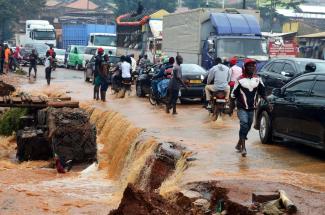Water in urban areas
Kampala’s water problems
 picture-alliance/Xinhua News Agency/Nicholas Kajoba
picture-alliance/Xinhua News Agency/Nicholas Kajoba
Water scarcity and a deficient sewer system are two of the major challenges Uganda’s capital is facing. Like many African metropolises, Kampala’s infrastructure is still based on the building standards of the former colonial government. Particularly in slums like Katanga, there is very little access to clean water.
The situation has deteriorated because infrastructure development has not been able to keep pace with the rapid population growth of recent decades: whereas about 130,000 people lived in Kampala in 1960, the last official census of 2014 showed that 1.5 million were residing in the city centre alone.
The Ugandan government recognises that Kampala has special needs as one of the most important urban centres in the country. Back in 2010, it passed a law called the Kampala Capital City Authority Act that created a semi-autonomous administrative unit with special departments to address the city’s most pressing concerns. The departments for land use planning and technical services are overhauling the city’s infrastructure, including the water and sewer systems.
Access to safe, clean water
The frequent water shortages in Kampala are particularly problematic. The National Water and Sewerage Corporation (NWSC) primarily extracts water from Lake Victoria and wells and treats it in water treatment plants. However, demand is often so high that the NWSC cannot supply all the households that are connected to the mains. Many people therefore rely on alternatives like water vendors, shallow wells or other sources of water, which are potentially contaminated.
In order to improve service, the NWSC is also working on increasing water production, installing an efficient wastewater-management system and preventing water and sewage leaks. The projects are being financed by a variety of organisations, such as the African Development Bank.
The Ugandan government is receiving additional support from European partners like the EU-Africa Infrastructure Trust Fund (EU-AITF), the European Investment Bank (EIB), the Agence Française de Développement (AFD) and the KfW Development Bank. As a result, in March 2021, the Katosi water-treatment plant was opened, which can produce 160,000 cubic meters of water per day.
Poorly maintained pit latrines
Nevertheless, the existing infrastructure cannot meet the needs of the growing population. A significant portion of wastewater flows untreated into Lake Victoria because it exceeds the capacities of the treatment plants. Inadequate hygiene practices and a lack of access to sanitary facilities are making matters worse: many residents rely on poorly maintained pit latrines. The faeces contaminate both surface-water sources and groundwater.
For that reason, the Ugandan government not only aims to expand and modernise its wastewater infrastructure, but also encourages communities to use sanitary facilities and not dispose of waste in the environment.
Because of the country’s poor drainage systems, heavy rainfall has led to increasingly frequent flooding in recent years. Large volumes of rainwater flood the streets and threaten people and their property.
At the same time, some people use heavy rains to empty their septic tanks. The faeces mix with the flowing water and create a strong stench. Combined with poor waste disposal and inadequate sewer systems, this practice is contributing to the spread of diseases like cholera.
Strategy for a smart city
In light of these challenges, Kampala has joined and now leads the Africa Smart Towns Network (ASToN), which has grown to include 12 African cities. The initiative was launched by France’s development agency in order to support African cities in the creation of sustainable urban systems. Following the model of Europe’s URBACT programme, the network should improve cities’ cooperation with regard to specific challenges.
At first, Kampala’s city administration concentrated primarily on solving mobility problems. Now, the lessons learned from that project are being applied to other areas, like addressing drainage and water problems. The authorities envision a “Smart City”: a sustainable urban area with clear organisational structures and infrastructure based on the latest technology.
In Kampala, modernisation is especially difficult because of the large number of residents. Many are active in the informal economy, and poor people in particular tend to resist efforts to modernise. They often see such measures as an existential threat because the change directly endangers their livelihood.
For example, the city administration is targeting street vendors because they are notorious for their poor waste disposal. Many leave their packaging and plastic waste on the streets, and it ultimately ends up in the municipal sewer system.
Over the past ten years, Kampala has worked with a variety of development partners in order to solve complex problems and position the city more sustainably step by step. Some success has been made: the city is addressing water and wastewater challenges better than it did a decade ago.
However, not nearly enough has been done. Some problems persist. Solving them will require cooperation between Kampala’s residents, the city administration, development partners and the country’s central government.
Ronald Ssegujja Ssekandi is a Ugandan author and edits D+C/E+Z’s Nowadays column.
sekandiron@gmail.com
